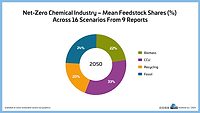According to a Recent Report, the Global Chemical Industry is Expected to Reach a Value of $24.4 Trillion in 2024

According to a report by MarketsandMarkets (MNM) titled, "Global Chemical Industry Outlook 2024 - Navigating the sustainable and disruptive Horizon of Tomorrow," the top seven chemical sub-industries will grow from $2.2 trillion in 2023 to $24.4 trillion by 2024 at a year-on-year increase of 8%. These segments will offer new opportunities, worth $165 billion in 2024, in the form of new technologies, sustainable solutions, new materials, and energy transition.
The industry is entering 2024 with a positive outlook. Despite the challenges in the past two years, the chemical industry is set to rebound with moderate growth in 2024. While challenges remain, the combined effect of rising demand, favorable regulations, and industry focus on sustainability, decarbonization, digitalization, and innovation is creating a strong foundation for growth and success in the years ahead.
To remain successful, companies will have to adopt changes that are likely to include deglobalization and supply chain localization. The chemical industry must confront conflicting regulations in supply chains and business lines. However, most chemicals are intrinsically multiregional rather than truly global products and intercontinental trade is still significant for many players.
In 2023, recessionary effects in Europe, inflation in the United States, and slower growth in Asia Pacific were some of the key contributors to the slow growth in global demand for chemicals. Many chemical companies around the globe posted negative growth in sales during the first three quarters of 2023.
Looking forward, in the United States, the demand for chemicals during the first nine months (Jan-Sept 2024) had been expected to be sluggish due to recessionary and inflationary effects in the country. In the fourth quarter of 2023, these started to ease, and demand is expected to see a modest rebound. The American Chemistry Council expects that the growth in the U.S. chemical industry will be at single-digits year-on-year through 2025.
In Europe, there had been a considerable fall in demand for chemicals in 2023 due to weaker demand from end-use industries, high energy cost, high raw materials cost, the Russian-Ukraine war, intensifying recessionary effect with rising interest rates, and inflation. The industry is rethinking its supply chain strategies to balance costs, its carbon footprint, and its resilience while navigating disruptions.
The Asia-Pacific region (APAC) proved to be a key growth driver, though not as much as expected during the start of the year 2023. APAC is expected to continue to hold two-thirds of the chemical market in 2024.
According to MNM, chemical companies around the globe are likely to enter the new year with caution, keeping their focus on reducing overall costs and improving process efficiencies to offset the losses incurred during the past years.
To learn more and download the report, visit www.marketsandmarkets.com/Market-Reports/global-chemical-industry-outlook.
Looking for a reprint of this article?
From high-res PDFs to custom plaques, order your copy today!





.jpg?height=200&t=1709670950&width=200)